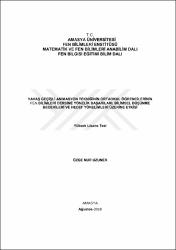| dc.contributor.advisor | Çakır, Recep | |
| dc.contributor.author | Uzuner, Özge Nur | |
| dc.date.accessioned | 2022-03-09T14:56:08Z | |
| dc.date.available | 2022-03-09T14:56:08Z | |
| dc.date.issued | 2018 | |
| dc.identifier.uri | https://tez.yok.gov.tr/UlusalTezMerkezi/TezGoster?key=fS4sqEZr79C_n60Rk6MjFZ0gbz0W8PeCCoS18TaVvR0DpJM3e1RMjc_SAPIVuvfo | |
| dc.identifier.uri | https://hdl.handle.net/20.500.12450/1840 | |
| dc.description.abstract | Bu çalışma yapılandırmacı yaklaşıma uygun olarak yavaş geçişli animasyon tekniğinin öğrencilerin akademik başarı, bilimsel düşünme becerileri ve hedef yönelimleri üzerinde etkisi incelenmek amacıyla yürütülmüştür. Çalışma 2015-2016 eğitim öğretim yılında Samsun ilinin Vezirköprü ilçesinde bir yatılı ortaokulun 7.sınıf öğrencileri ile gerçekleştirilmiştir. Nicel araştırma yöntemlerinden yarı deneysel yöntem ile yürütülen çalışmada deney grubu 23 kişi kontrol grubu 22 öğrenciden oluşmaktadır. Öğrenme konusu olarak Elektrik Enerjisi ünitesi belirlenmiştir. Kontrol grubunda öğrenme halkası modeline dayalı ders kitabında yer alan etkinlikler uygulanırken, deney grubunda öğrenme halkasına dayalı yavaş geçişli animasyon tekniği ile dersler yürütülmüştür. Veri toplama aracı olarak araştırmacı tarafından geliştirilen Elektrik Enerjisi Ünitesi Başarı Testi, Göktürker (2005)' in ortaya koyduğu Bilimsel Düşünme Becerileri Ölçeği ve Elliot ve McGregor (2001) tarafından geliştirilmiş, Şenler ve Sungur (2007) tarafından Türkçe 'ye uyarlanmış Hedef Yönelimi Ölçeği öntest ve sontest olarak kullanılmıştır. Ayrıca süreç sonunda öğrencilerin derslerde yavaş geçişli yönteminin kullanımına dair görüşlerini öğrenmek amacıyla 3 soruluk yarı yapılandırılmış görüşme formu verilmiştir. Uygulama haftada 4 saat olmak üzere 6 haftada tamamlanmıştır. Elde edilen verilerin analizi SPSS programı ile gerçekleştirilmiştir. Bulgular incelendiğinde yavaş geçişli animasyon yönteminin öğrencilerin akademik başarısını artırdığı ve kontrol grubu ile aralarında deney grubu lehine anlamlı farklılık olduğu görülmüştür. Hedef yönelimleri ve bilimsel düşünme becerileri olarak ise deney ve kontrol grupları arasında anlamlı bir fark oluşmamıştır. Görüşme formunda yer alan verilere göre deney grubu öğrencilerinin yavaş geçişli animasyon yöntemi ile işlenen dersin eğlenceli, öğrenmeyi kolaylaştırıcı olduğu ifade edilirken yöntemin zaman alıcı olduğu da ifade edilmiştir. Yavaş geçişli animasyon yönteminin okullarda kullanımını yaygınlaştırmak için gerekli teknolojik araçların temin edilmesi ve öğretmenlerin bu yöntem hakkında bilgilendirilmesine yönelik çalışmalara ihtiyaç olduğuna dair önerilerde bulunulmuştur. | en_US |
| dc.description.abstract | This study was conducted to examine the effects of slowmation technique in accordance with constructivist approach on students' academic achievement, scientific thinking skills and achievement goals. The study incorporated with 45 7th grade students from Samsun/ Vezirköprü Boarding Middle School and took place in 2015- 2016 academic year. A quasi experimental design which is one of the quantitative methods was used in this study. Groups were formed neutral as experimental and control. The experimental group consisted of 23 students and the control group of 22. The Electrical Energy unit was identified as the learning topic. While the control group was thought through learning cycle model which is accordance with constructivist learning approaches. On the other hand the experimental group was instructed via the slowmation technique. As data collection tools; Electrical Energy Achievement Test created by the researcher, the Scientific Thinking Scale, which was put forward Göktürker (2005), The Achievement Goals Scale developed Eliot and McGregor (2001) which was adapted to the Turkish context by Senler And Sungur (2007). These were used pre - and post- tests. After the pre- and post- tests stages, unstructured interviews consisting of 3 questions were given to students to collect students' views on the effectiveness of slowmation method. The study was completed in six weeks in which four hours per week. Data analyzing was conducted through SPSS program. The results indicated that the slowmation technique enhanced students' academic achievement. The results clarified that the experimental group outperformed the control group in a significant way. There was not a significant difference between the two groups with regards to scientific thinking skills and achievement goals. As to data on interviews form shows that the students in the experimental group enjoyed the lessons in which the slowmation technique was used and they indicated that it was easier to learn although it was quite time consuming. It is suggested that necessary technological tools should be provided to promote the usage of slowmation technique in schools and also inform the teachers about this method. | en_US |
| dc.language.iso | tur | en_US |
| dc.publisher | Amasya Üniversitesi | en_US |
| dc.rights | info:eu-repo/semantics/openAccess | en_US |
| dc.subject | Eğitim ve Öğretim | en_US |
| dc.subject | Education and Training | en_US |
| dc.title | Yavaş geçişli animasyon tekniğinin ortaokul öğrencilerinin fen bilimleri dersine yönelik başarıları, bilimsel düşünme becerileri ve hedef yönelimleri üzerine etkisi | en_US |
| dc.title.alternative | The effect of slowmation technique in science education on the secondary school students' achievement towards science lesson, scientific thinking skills and achievement goals | en_US |
| dc.type | masterThesis | en_US |
| dc.department | Enstitüler, Fen Bilimleri Enstitüsü, Matematik ve Fen Bilimleri Eğitimi Ana Bilim Dalı | en_US |
| dc.identifier.startpage | 1 | en_US |
| dc.identifier.endpage | 129 | en_US |
| dc.identifier.yoktezid | 527408 | en_US |
| dc.institutionauthor | Uzuner, Özge Nur | |


















